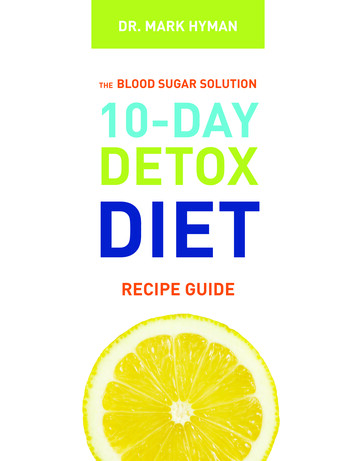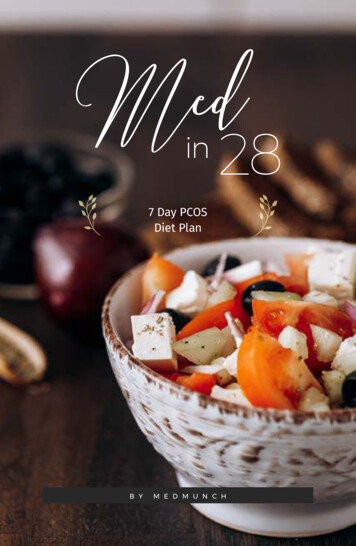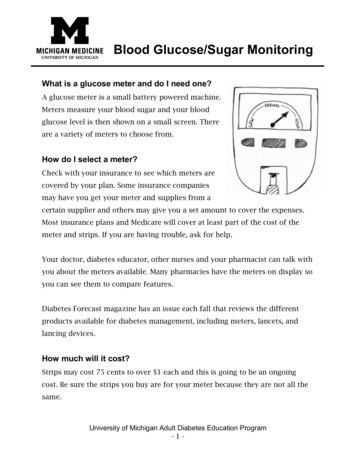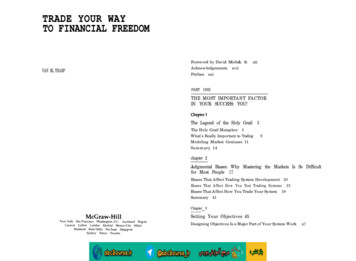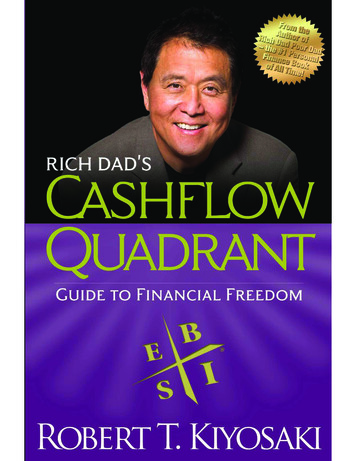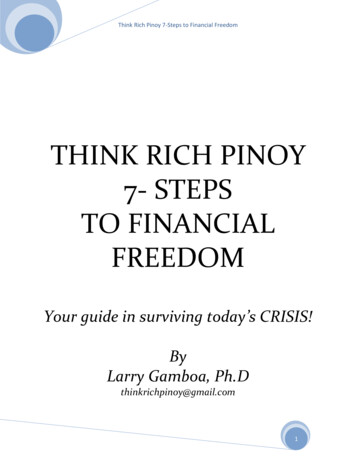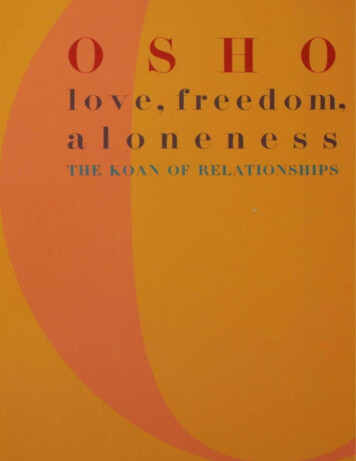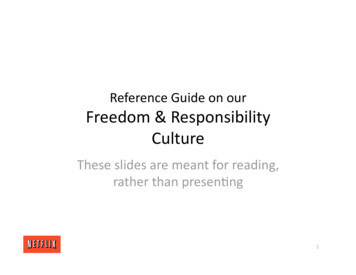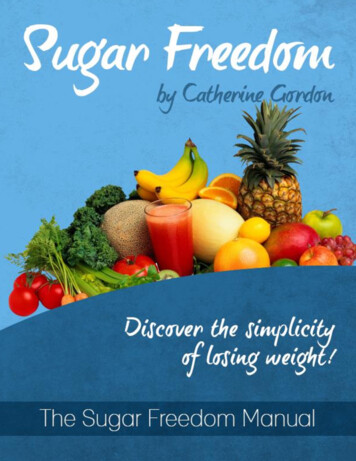
Transcription
The Sugar Freedom DietBy Catherine Gordon CPT
Legal DisclaimerThe information presented in this work is by no way intended as medical advice or as asubstitute for medical counseling. The information should be used in conjunction withthe guidance and care of your physician. Consult your physician before beginning thisprogram as you would with any exercise and nutrition program. If you choose not toobtain the consent of your physician and/or work with your physician throughout theduration of your time using the recommendations in the program, you are agreeing toaccept full responsibility for your actions.By continuing with the program you recognize that despite all precautions on the part ofCatherine Gordon, there are risks of injury or illness which can occur because of youruse of the afore mentioned information and you expressly assume such risks andwaive, relinquish and release any claim which you may have against Catherine Gordon,or affiliates as a result of any future physical injury or illness incurred in connection with,or as a result of, the use or misuse of the program.
Introduction3“How Did You Do It?”3What is Sugar Freedom?3The Bread Thief3is Sugar Freedom For You?3Love Thy Vegetables3A: Artichoke, Avocado, Asparagus, Acorn Squash, Aubergines,3Sugar Freedom: A Diet That’s Moderate in Protein.3The Sugar Freedom Plan: Carbohydrate, Protein, and Fat3Time to Talk About Fat3Two Fats to Avoid on Sugar Freedom:3Three Fats to Enjoy on Sugar Freedom3So there you have it: The basic design of the Sugar Freedom Plan.3Sugar Freedom Meal PlansIntroductionThe Three Day Sugar Strike333A Sample Day on the Sugar Strike:3Sugar Freedom and Fat Loss3What can you expect from the Sugar Freedom Diet?3A Sample Day on the Sugar Freedom Diet3Five Things You Must Do To Lose Fat For Good3
Eat well, train wisely, rest and recover, and your ideal body will emerge.Introduction“How Did You Do It?”Back in 2010 when I finally reached my ideal goal weight of 117 pounds, after almost40 years of dieting, people started asking me that question. They were usually womenaround my age of 46 or older.That question is the reason why I am writing this diet plan. There are a growing numberof diets available that eliminate sugar, flour, and processed oils and fats. Indeed, TheSugar Freedom Diet owes a large debt to the work of physicians and researchers likeDr. Robert Atkins, Dr. Eric C. Westman, Gary Taubes, and Dr. Stephen Phinney, andDr. Robert Lustig who have either implemented the sugar and grain free strategy withtheir patients, or informed the world about its effectiveness.I am writing this program because I believe that we receive what we want for others,and that one of the best ways to keep excess fat off for good is to teach other peoplehow to do the same thing.In my work as a Certified Turbulence Trainer at Gordon Studio in Sonora, CA, I havehad the incredible experience of helping clients lose fat, and transform their bodies forgood. Although my professional certifications (ACE and CTT) are in personal training,and I am not a dietitian or nutritionist, I simply cannot remain silent any longer about theeating strategy that actually helped me lose a grand total of 68 pounds, and that haskept the excess fat off of my body for that past five years and counting.The eating strategy that released me from my mad obsession with bread and sweets,and allowed me to enjoy nourishing food in healthy amounts, runs counter to theestablished nutritional guidelines of the USDA, so I must urge you to consult your doctoror licensed health professional before implementing this eating plan.The good news is that here in Sonora, CA and around the world, more and moredoctors, dietitians, nutritionists, and other health care providers are standing up for theidea of Sugar Freedom. I am writing this program to lay out step by step how a real lifelong sugar addict broke the chains of over-eating, and got the life and body of herdreams.My fondest wish is to share and teach what I have learned, and give you the freedom tocreate the body you have always wanted.Then, you will have all of the energy and confidence you need to go out and live the lifeof your dreams.
What is Sugar Freedom?Sugar Freedom is an eating strategy that eliminates sugar, grains, and processed oilsfrom the diet. It is also a collection of tactics that will help you to satisfy your appetite,and stick with your eating plan.A few years back, I came up with a formula for permanent fat loss:E MTThat stands for Eating Plus Movement Over Time.Although my mind is still open to the possibility that mechanisms other than caloriebalance are at work when it comes to losing fat, and thereby losing weight, my personaland professional experience leads me to believe that we use up our excess fat storeswhen the body requires more energy for movement, maintenance, and repair, than it iscurrently getting from food.Regardless of the mechanism for fat use, a system which is autonomic and not underour conscious control, we are in charge of our eating behavior.Our eating choices are the most powerful determinant of what gets used as fuel in thebody. Pardon my bluntness, but if you don’t eat it, your body can’t use it or store it. Forthat reason, The Sugar Freedom Diet is intended to help you make the food andbehavior choices that will cause your body to use fat as fuel.I will add here that I agree that the hormones insulin, leptin, and cortisol have a powerfuleffect on fat storage and release, and the amount and quality of sleep and exercise youget make a big difference in whether or not your fat loss plan is successful.My work and experiences have convinced me that you can manage what you eat andhow you move, in order to shed unwanted fat and keep it off of your body. Permanently.So, what makes you want to eat? More importantly, what makes you want to overeat?The answer to that question is appetite.Appetite is different from hunger. Hunger is the physiological need to eat, and appetiteis the desire to eat. The Sugar Freedom Diet is intended to help you manage both thephysical need and the desire to overeat.
The Bread ThiefOne of my earliest childhood memories involves my first bread binge.I am five years old, and I am alone in the kitchen of our family home back in Indiana. Ican still see the curtains over the window, and the cupboard next to it where we keepthe Weber Bread. If you’re unfamiliar with Weber bread, it was white, soft, and it camein a wrapper that had a comic strip on the back.Yes, even back in 1969 the food manufacturers understood the power of marketing theirsoft white bread to children.I remember climbing up on the counter, (I was too short to reach the bread otherwise)taking down the bread, and pulling out the second slice. I would never eat the end slice!I tore off the crust, crushed the white part of the slice in my little hand to make it moredense and yummy to my taste, and I ate it in four bites. I repeated this behavior withslice after slice until half the loaf was gone. I knew instinctively that what I was doingwas wrong, so I stopped short of eating the entire loaf. That would have run the risk ofgetting me caught and scolded in front of my older brothers and sisters, who wouldnever eat half a loaf of bread all at once!So on that day I started my career as a bread, cookie, cake, ice cream, and chip thief,and that compulsion follows me to this day. As recently as last year, I was out to dinnerat an Italian restaurant with my husband and son. Near the end of the meal they left touse the men’s room, and I ate four slices of garlic bread right off of their plates whilethey were gone. This triggered a bout of overeating, standing by myself in the kitchen,that lasted until I went to bed that night. The feeling was just the same as it had been 43years ago, shame, fear, and bewilderment at my own actions.I know that sounds awful, but the good news is that the next morning I got right back tomy Sugar Freedom strategy, and after 24 hours the horrible compulsive craving wasgone.Now, I am aware that there are some nutrition and diet experts who would claim that Istole that bread because I had been denying it to myself. They would say that if I simplyate bread and sweets regularly and in normal amounts I would never binge on theseitems.If you are like me, however, and you’ve felt the carb compulsion for yourself, you wouldknow how cruel and unreasonable that instruction is.
But what if you’ve never resorted to strange behaviors like eating an entire bag of hotdog buns (Yes, I’ve done this) or swiping food from your room-mates when they’vealready asked you to stop ? (Done that too.) Does it make sense for you to seek SugarFreedom by eliminating sugars, grains, and processed oils?is Sugar Freedom For You?Ask yourself the following questions.1. Are there certain foods I can’t stop eating even after a standard serving?2. Are there foods that make me feel hungrier after I eat them than I was before?3. Does eating cause me to feel regret more than once a week?4. Do I make resolutions about eating in the morning, only to break them in theafternoon?5. When I eat snack foods like sweets or chips, do I get a brief feeling of intensepleasure?6. Is that feeling followed by remorse?7. Do I continue to eat in spite of the emotional pain it causes, until I’m so full that ithurts physically?8. If you answered “Yes” to any of these questions, what are the foods that typicallytrigger these behaviors?If the preceding questions, and the behaviors they describe, resonate with you, and thefoods that trigger you are sugar, and the foods that quickly convert to sugar in thebloodstream like grains and other starches, The Sugar Freedom Diet can give you morethan fat loss.It can give you release from the obsessive hungers and food related habits that interferewith your ability to live the live of your dreams in the body you desire.Question: How do I get off of sugar?Answer: Eat something else.Is it really that simple? Yes it is.As soon as you decide to eliminate sugar for as long as it takes to reach your goal, youcan learn what to eat instead of sugar containing foods. There is a whole world of tastyfood out there that doesn’t contain refined sugars or grains.On the Sugar Freedom Diet you will learn to put together a daily menu of foods that issatisfying, delicious, and packed with nutrients. Let’s get to the list.
Love Thy VegetablesThe typical assumption when it comes to a low sugar diet is that, if it’s low in sugar andfoods that rapidly convert to sugar in the body, it must be higher in protein and fat.Higher than what? The USDA has established these guidelines for the threemacronutrients: carbohydrate, protein, and fat:65% of calories should come from carbohydrate.10% - 35% of calories should come from protein.20% - 35% of calories should come from fat.On the Sugar Freedom Diet, it is true that the percentage of calories consumed ascarbohydrate will be lower. I have beentracking my macronutrient intake for more thanfive years, and the truth is that, when I want torelease fat and lose weight, I keep mycarbohydrate intake below 20%.This is where we return to the honesty Ipromised you in the introduction to the SugarFreedom Diet.It is seriously politically incorrect to admit that Ieat that small of a percentage of carbohydrateas part of my eating plan.At first glance, 20% seems very low, but if youlook at carbohydrate foods as a percentage ofthe volume of the Sugar Freedom Diet, they are actually the component that fills most ofyour plate!
Here is an example of a recent breakfast.In the photo, you can see that vegetables cover most of my plate. Here you seecauliflower, cabbage, tomatoes, and onions, seasoned with organic ginger, currypowder, and iodized sea salt, and topped with avocado. (Oh boy, I can’t wait to cookand eat this dish again!)So yes, of course carbohydrates are a big part of the Sugar Freedom Diet, and thosecarbohydrates will come chiefly from non-starchy vegetables.Check out all of the amazing vegetables on the following list!Vegetables on the Sugar Freedom Diet:A: Artichoke, Avocado, Asparagus, Acorn Squash, Aubergines,B: Broccoli, Bean (Green), Beet, Beetroot, Brussels Sprout, Bok Choy, Bell Pepper,,Bamboo shoot, Butternut Pumpkin, Butternut Squash, Buttercup Squash, ButterheadLettuce, Broccoli Rabe, Broadleaf arrowhead.C: Cauliflower, Cabbage, Carrot, Celery, Cilantro, Chard, Chinese Cabbage, ChineseChives, Chives, Collards, Cucumber, Cress, Chili Pepper, Chilies, Cardoon, Celeriac,Camas, Canna, Cassava, Carola, Calabrese, Champagne Melon, Courgette, CustardSquash, Chicory, Coral Lettuce, Cos Lettuce, Capsicum, Cherry Tomatoes,Chrysanthemum leaves, Cayenne Pepper, Cape Gooseberry, Cherry tomatoD: Dill Pickle, Dandelion, Daikon RadishE: Eggplant, Elephant Garlic, Endive,Escarole.F: Flowering cabbage, French bean, Fiddlehead, Fennel.
G: Gherkin, Garlic, Ginger, Green beans, Garden Pea, Globe Artichokes, GoldenNugget Squash.H: Hot-House Cucumber, Haricot Beans, Hubbard Squash, Habenero PepperI: Italian Red Onion, Iceberg lettuce, Ice Plant, Indian PeaJ: Jalapeno Pepper,Jerusalem artichoke, Jicama.K: Kale, Kohlrabi, Kai-lan, Komatsuna, Kuka, Kurrat, Kombu, Kosher PickleL: Leek, LettuceM: Mushroom.N: Napa CabbageO: Onion, Okra, Olive, Oakleaf Lettuce.P: Pepper, Parsley, Pea, Pickle, Pumpkin, Pattypan squash, PurslaneQ: QuinceR: Radish, Rutabaga,Ridge Cucumber, Rockmelon, Runner Bean, Radiccio, RainbowChard, Rocket, Radicchio, Rice bean, Romaine LettuceS: Spinach, Squash, Shallot, Scallions, Sprouts, Sorrel, Swiss chard, Sweet potato,Sea lettuce, Spanish Red Onion, Spring Onions, Savoy Cabbage, Spring Greens,Spaghetti Squash, Snow Peas, Sugarsnap Peas, Summer Squash, Sweet pepperT: Tomato, TomatillosV: Vidalia Sweet OnionW: Watercress, White Egpplant, White Radish, Winter melon, Wild leek, Waterchestnut,Y: YamZ: ZucchiniWow, that’s a mouthful, and more!An essential key to success on the Sugar Freedom Diet is the ability to find vegetablesyou love, and and prepare them in ways that are delicious, and keep them interestingand satisfying.
(On a personal note, I have a truly severe tendency toward compulsive overeating, andnon- starchy vegetables are my best friends when it comes to feeling nourished andsatisfied, without getting triggered into food obsession and overeating.)Sugar Freedom: A Diet That’s Moderate in Protein.The USDA has established guidelines for recommending a protein intake of between10% and 35% of total daily calories. Protein is an essential macronutrient for buildingbody tissue, and it is also a source of energy.It is important to note that when we consume more protein that the body needs, it canbe converted to glucose through the process on gluconeogenesis. Glucose is a form ofsugar that triggers an insulin response, allowing the extra protein to be converted andstored as fat.So how much protein is considered ideal on the Sugar Freedom plan?According to the USDA and the National Academy of Sciences, you may need moreprotein than the established RDA if you engage in strenuous physical activity andtraining.According to researchers at Iowa State University, the recommended intake in this caseis 1 to 1.8 grams of protein per kilo, (Or 2.2 pounds) of bodyweight per day.So, an active female who weighs 140 pounds might use this calculation:140/2.2 64 (rounded up) 64X1.4 90So 90 grams of protein per day would be a good starting point for a female in training. Ifwe assume 7grams of protein per ounce, we get a total of 12-13 ounces of protein perday.To put it in terms of meal planning, that would allow for 4 ounces at breakfast, lunch,and dinner, plus one ounce as part of a snack. Those three servings of protein at mealsshould translate to about the size and thickness of the palm of your hand.The Sugar Freedom Plan: Carbohydrate, Protein, and FatSo, The Sugar Freedom Plan consists of 5-10 servings of carbohydrate a day as nonstarchy vegetables or fruit, moderate protein as calculated above, and adequate fat toachieve satiety.
Time to Talk About FatYes indeed, fat is one of the primary keys to success on the Sugar Freedom Plan,whether you’re on the Three Day Sugar Strike, The Sugar Freedom Diet, or the SugarFreedom Lifestyle Plan.The trouble with fat is that some fats are really good for you and other fats. No somuch.Two Fats to Avoid on Sugar Freedom:1. Trans Fats: Also known as hydrogenated and partially hydrogenated fats, these havebeen proven to be unhealthy in any amount. Avoid them completely.2. Processed vegetable oils. Please eliminate soybean oil and canola oil during allstages of Sugar Freedom. For that matter, leave them out for good.Three Fats to Enjoy on Sugar FreedomIn addition to the fats that are part of the whole foods on the Sugar Freedom Plan, forexample the fat in pastured eggs or grass fed beef, please use:1. Organic extra virgin olive oil2. Pastured butter like Kerrygold3. Organic coconut oil.For variety, nut oils like macadamia and walnut may be included to add unique flavors,and avocados are a delicious addition to many different dishes.In general, the amount of fat to use is simply what works best to make your food simpleto prepare, and delicious to eat.Here are some examples: When I cook chicken thighs, I use an equal amount of butterand olive oil in a pan: usually 2 tablespoons of each.To dress salads, use 1-2T olive oil plus organic vinegar to taste.To cook a morning omelet in a small egg pan: 2 teaspoons of coconut oil works well.So there you have it: The basic design of the Sugar Freedom Plan.Now it’s time to learn how to use the plan to get satisfied, energized, and lose excessbody fat for good!
Get ready to learn and implement an eating strategy that puts you in charge of yourappetite by giving you a feeling of satisfaction and well being that is a splendid trade forthe sugar, flour, and fake fats you are leaving behind.Your first step is to end your cravings for sugar, grains, and processed fats by eatingsomething else.It’s time for the Sugar Strike!
Sugar Freedom Meal PlansIntroductionWelcome to the meal plans everyone. I admit that when I have bought a diet book orprogram, I usually turn to this section with the burning question:“What can I eat? How much? How often?”This is also the principal answer to the question that prompted me to write the diet in thefirst place. When someone sees or hears about my significant and long lasting fat loss,and they ask, “How did you do it?” The answer lies in what I ate, and in the way Icontinue to eat for maintenance five years on.There are two different meal plans on this program. The first is the Three Day SugarStrike, which is a three day low carb, high fat, moderate protein plan that will free youfrom your sugar cravings, or your money back.Seriously, if the Three Day Sugar Strike doesn’t give you relief from sugar, sweet, andstarch obsession, and it doesn’t significantly reduce your appetite, your investment willbe cheerfully refunded.I understand that everyone who wants to lose weight isn’t addicted to sugar, grains, andstarches. From my research, it is likely that approximately 15% of the overweightpopulation would score high enough on a sugar addiction questionnaire to beconsidered to be affected by this compulsion. That means that the majority of dietersdon’t need a program that completely eliminates sugar and grains to lose fat.However, for those of us lucky few in that 15%, the elimination of sugar, grains, andprocessed fats can bring a relief from cravings, food obsession, and overeating, and apeace that is sweeter than any conventional dessert.If you are familiar with the Induction Phase of the Atkins Diet, you will notice similaritiesto the Sugar Strike. The primary difference is that non-starchy vegetables are notlimited on the Sugar Strike. This means that you could easily consume more than 20grams of carbohydrate each day.
The Three Day Sugar StrikeDays I, 2, and 3:Eliminate all sugar, grains, fruits, and starchy root vegetables. In addition, eliminatevegetable oils like canola and soybean oil.(A note on fruit: Yes, fruit is incredibly healthy as it is full of fiber and nutrients. It does,however, contain fructose, and I have found from self-experimentation and experiencethat leaving it out on the Sugar Strike is extremely helpful for eliminating sugar cravings.Up to two servings of fruit a day will be back on the Sugar Freedom Diet if the fruitdoesn’t trigger cravings or over-eating.)Eat vegetables, especially green leafy vegetables that grow above the ground.Eat high quality sources of fat like pastured grass fed butter, organic coconut oil, andorganic olive oil.Eat high quality sources of protein like pastured eggs, grass fed beef, free range pork,organic free range chicken and wild caught fish.Eat full-fat organic dairy foods, raw if available and you’re comfortable with consumingraw dairy. On the Sugar Strike the best dairy items are heavy cream, up to two ouncesa day, Full Fat Organic and Greek Yogurt: up to one cup a day, and full fat organiccheese, up to three ounces a day for men, two ounces for women.A note on eggs and dairy: Some individuals may be sensitive to these items and as aresult, may not get the same drop in appetite as those who tolerate them well.If you have a history of being triggered by dairy: for example you find that you regularlyovereat when it comes to cheese, keep an eye on how it affects your appetite on theSugar Strike.Follow your instincts. By the middle of day two your appetite should be lessening, so ifyou find yourself craving more and more of something on the sugar strike, first eat morevegetables to make sure you’re getting enough fiber, volume, and nutrients to satisfyyour body’s hunger, and then eliminate the trigger food if necessary.
Here’s a specific example from my experience. A few weeks ago, I orderedsome beef snack sticks from an organic grass-fed beef company. They weresugar free, ready to eat when thawed, convenient, and delicious.Unfortunately, I discovered that I could eat four at a sitting, especially whendipped in my home made mayonnaise, and even after eating them, I still feltlike I wanted to eat more. My stomach was physically full, but my appetitewasn’t satisfied. Yes, I was triggered!Here’s the key point:If a standard serving of a food not only doesn’t satisfy you, it makes you hungrierthan when you started eating, it is a trigger food, and you need to leave it off yourmenu until you reach your goal.Once you have reached your fat loss goal and maintained it for four weeks, you maywant to re-introduce foods that previously over-stimulated your appetite. But for thetime period covering the Three Day Sugar Strike, and the Sugar Freedom Diet, it is theelimination of appetite-stimulating foods that gives you the power to stick to your fatreleasing food strategy.Remember the very simple premise of Sugar Freedom, in the form of this question andanswer:Q. How do I get off of sugar?
A. Eat something else.For the three days of the Sugar Strike, “Something Else” is non starchy-vegetables, highquality proteins in the form of meat, fish, fowl, and eggs, and healthy fats.To put it simply, you are trading variety for satiety.
A Sample Day on the Sugar Strike:Breakfast:Coffee with 1t heavy cream, and a few drops of liquid stevia if you need sweetener.2 egg omelet made with 1/2 oz cheese, cooked in 1t Kerrygold butter2 cups mixed vegetables cooked in 1T organic coconut oil.Make extra servings of vegetables to have with lunch.Lunch:3 to 4 ounces high quality protein like 2 organic chicken thighs.Large green salad: 2C salad greens mixed with 1C chopped cucumber, tomato, andcelery.Home made salad dressing: 1T organic olive oil with 1 to 2 tablespoons Braggs AppleCider Vinegar, and 2 drops liquid stevia to take the sour edge off of the dressing ifdesired.Dinner:3 to 4 ounces high quality protein, example: Grass Fed Beef Rib Eye, one or twoservings of a cooked vegetable, for example: Cauliflower Au Gratin, 2 cups leafy greenswith 1 cup salad vegetables with home made dressing.I don’t find it necessary to snack between meals on the Sugar Freedom Diet, but that isa personal choice based on the fact that I feel and perform better when I eat threemeals a day sitting at a table.However, on the Three Day Sugar Strike, the goal is to get off of sugar, grains, andprocessed fats without hunger.In order for the Sugar Strike to work you must not go hungry, and the way to do that isto eat enough vegetables, protein, and fat to stay satisfied. If you count the servings ofvegetables in the sample sugar strike menu, you’ll see that it’s total of seven or more!The best tactical advice I can give you is to use the shopping list in this manual, stockup on the foods you need, and prepare enough of them in advance so that you won’t betempted to eat anything else.
Grass-Fed Beef Lettuce Wraps with Bell Pepper and TomatoHere are some Sugar Strike preparation strategies:1. Roast a whole organic chicken, or cook one in a slow cooker, remove the meat andmake stock from the bones. Stock is great to use in so many different dishes. You canfreeze the stock in ice cube trays, and then just pop one of the cubes in the pan whenyou’re cooking if you need liquid to de-glaze or keep foods from sticking.2. Make a big pan of mixed sauteed vegetables each day. I do this every morning sothat I have a cooked vegetable ready to serve with lunch, or you could make extraservings and store them in the freezer.3. Wash your lettuce as soon as you get it home from the store. I use a salad spinner,and then I put the clean lettuce in a ziploc bag with a piece of paper towel to absorbexcess water.If you’re not willing to do this, you may want to spend the extra money on boxes of prewashed organic greens that are available now- at least for the three days of the SugarStrike. It will allow you to put a green salad together in less than a minute by tossingthe lettuce onto a plate, throwing on some grape tomatoes, and dressing it with olive oiland vinegar.Each morning, write down your eating plan for the day. The Sugar Strike menu is verysimple, so it shouldn’t take long to jot down what you’ll be making. A big bonus to this isthe fact that it works, and when you’ve released all the fat you wanted to you will want tohave a record of the foods that freed you from the call of sugar.
The Three Day Sugar Strike Shopping ListNo Sugar, No Grains, No Processed Vegetable Oils No Cravings!1. In The Produce AisleEat a variety of non-starchy vegetablesSalad Greens (lettuce, spinach, cabbage)Other Leafy Greens (Swiss chard or other chard, collard greens, kale, bok choy)Herbs (basil, parsley, cilantro)Other salad vegetables (radishes, sprouts, cucumbers, tomatoes)Other green vegetables (avocado, asparagus, broccoli, green beans, Brussels sprouts,okra, also cauliflower)Other non-starchy vegetables (peppers, green onions, eggplant, artichokes,mushrooms)2.Meat, Poultry, Fish, Seafood, EggsDo your best to stick to unprocessed organic meats that you prepare yourself. Eggs areextremely nutritious, especially local free-range eggs.Beef: All cuts, especially grass fed. The recent studies which have connected red meatwith poor health outcomes have used conventionally raised beef which is fed grains andcorn. Grass fed organic ground beef has come way down in price, and other cuts canordered from www.grasslandbeef.com. It may be wise to limit your consumption ofconventionally raised and processed beef and pork.PorkPoultryFishShellfishI do use the wild salmon that comes in a can or a pouch to get in my omega 3 rich fishat a lower price. I have definitely experienced sticker shock at the price of fresh wildcaught fish.
3. Dairy CaseCream, butter, full-fat cottage cheese , sour cream, cheeses, ricotta, full fat yogurt withno sugar added, including Greek yogurt. You can even make dessert on the Three DaySugar Strike by mixing 1/2 cup of full fat yogurt with 1oz. chopped raw walnuts oralmonds with a few drops of liquid stevia, and a sprinkle of pure cinnamon.Once again, look for organic dairy. Remember total dairy 1 cup a day on the SugarStrike due to the lactose content of dairy foods other than heavy cream.4.Fats and OilsNote that some of these are high in saturated fats (butter, coconut oil). My experienceand research shows that saturated fats are actually beneficial in the context of a lowcarb diet. Avoid oils which are high in omega-6 fats (soy, corn, most safflower andsunflower). Partially hydrogenated oils should always be avoided.Butter (From grass fed cows like Kerrygold Butter)Coconut oil (Organic)Organic Extra Virgin Olive Oil.I also recommend local olive oil if it is available. Many times local oils won't be certifiedorganic because of the expense of certification. I adore lemon infused olive oil forhome-made salad dressing and mayonnaise.When I cook chicken, steaks, or pork chops on the stove I use a mixture of butter andolive oil in the pan.Other oils in small amounts as flavoring (sesame and nut oils)Other high-fat foods: nuts, avocados, and cream.A note on nuts and avocado on the Sugar Strike- 1 to 2 oz of nuts today, and oneavocado per day due to their higher carb content.Frozen FoodsIt's a good idea to have frozen meats, fish, and vegetables on hand. Don't forget tothaw your meat in the refrigerator, or in a sink of cool water in time to cook it!Canned GoodsCanned versions of the above vegetables, also olives.
Nuts and Seeds1-2 oz of raw organic almonds or walnuts per day are fine. Be aware that it’s easier togo overboard with nuts than say, broccoli. You may want to remind yourself that if youeat much more than you intended to at a sitting, you will need to leave them out of youreating plan. I do recommend measuring or counting nuts- 1 oz of almonds isapproximately 21 pieces.CondimentsMustard, home made mayonnaise, salsa, pesto, dill pickle- up to
The Sugar Freedom Diet is intended to help you manage both the physical need and the desire to overeat. The Bread Thief One of my earliest childhood memories involves my first bread binge. I am five years old, and I am a
